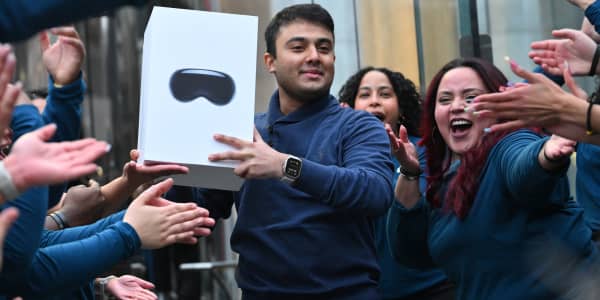Google Glass may be shattered, but ...
Google has gone back to the drawing board with Glass, but wearable technology—an up-and-coming product class for the past few years—finally seems poised to burst into the mainstream.
Once restricted to the athletically minded and early adopters of tech, wearables are priming for tremendous growth. According to CSS Insight's latest global wearables forecast, sales are predicted to jump from 29 million units in 2014 to 172 million by 2018, with the biggest spike expected to take place this year. Juniper Research is even more optimistic, seeing global revenues from wearables hitting $53.2 billion by 2019, a nearly 12-fold increase over 2014.
That projected growth, not surprisingly, includes all sorts of new products, with a wide range of focuses. Here are 10 wearables expected to launch this year that might be worth keeping an eye on.
Apple Watch
If there's one wearable everyone is watching, it's this. The Apple Watch is expected to account for 25 percent of the wearables market this year, said CCS Insight. Available in three versions, Apple is promoting this as a comprehensive health and fitness device, though with the app market, it will likely quickly evolve beyond that. Apple has shown a variety of demos already, including letting the watch unlock hotel rooms at SPG properties, locating your BMW in a crowded parking lot and receiving push updates from airlines. The biggest questions are price and battery life. The Apple Watch will start at $349 but will run much higher, depending on the model you choose. And it's still unclear how often you'll have to recharge it.
Fitbit Surge and Charge
Fitbit was an early leader in the wearables space, and despite a setback last year with the recall of its flagship product, the Force, it's still a company to watch. This year it has released two new fitness trackers: the Surge and the Charge. The Surge is the new top-of-the-line model, with a GPS tracker, caller ID and music controls on top of its usual health-tracking elements. It also features an always-on watch face. But some users are once again complaining about rashes—FitBit had to recall a device last year—which could cause more troubles for the company.
Skully Motorcycle Helmet
Imagine the best features of Google Glass in a motorcycle helmet and you start to get a good idea of what Skully hopes to offer. Equipped with a heads-up display, a 180-degree rearview camera and GPS navigation, this DOT-approved helmet also lets you voice-control your phone and music. With an expected July delivery, the Skully is already back-ordered, despite its hefty $1,500 price tag.
SMS Audio BioSport Earbuds
One of the biggest frustrations with most wearables is the need to regularly charge them. That's something you don't have to worry about with these high-end earbuds. With an embedded biometric sensor, they're able to collect fitness data, including the user's heart rate, and feed it directly to your phone. A collaboration between musician 50 Cent's SMS and Intel, these sweat- and water-resistant earbuds cost $150.
TAG Heuer Smartwatch
While the luxury watchmaker has confirmed plans to jump into the smartwatch category this year, it has not yet shown off a prototype or offered a complete list of the features it plans to include. Health monitoring and GPS features are certainly on the way, as well as apps specific to the sports it sponsors (which tend to be car-racing events and marathons).
Pebble Time
Pebble kicked off the smartwatch category—and with the Apple Watch looming, it's not backing down from the fight. Today the company unveiled its next-generation product, which includes a color screen, thinner design and microphone, allowing you to interact vocally with the device. Pebble Time is compatible with the more than 6,500 apps that exist for the current Pebble Watch. As with the original, the company turned to Kickstarter to launch the device, selling it for $159. It doubled its campaign goal of $500,000 in just 33 minutes. After the campaign ends, the price will jump to $199.
Digitsole
Fitness trackers don't have to live on your wrist. Digitsole is an insole for your shoes that can keep better track of your daily steps (and, presumably, calories burned) and even keep your feet warm. The $200 soles transfer data via Bluetooth and, as a bonus, add a layer of padding in your footwear to absorb shock and vibrations as you walk and run.
Oculus Rift
Officially, there's still no launch date for this virtual reality headset, so it may not be available in 2015, but every indicator seems to be pointing to a holiday release. The company, now part of the Facebook fold, has said its latest demos are on par with what the consumer version will be, with integrated surround sound and belief-suspending visual effects. And with mobile versions of the device already on the market via product partner Samsung, it's now a matter of ensuring that there's an adequate software catalog to support the Rift when it makes it debut.
Quell
Rather than focusing on tracking your daily activities or acting as a digital assistant, Quell is a wearable meant to help people who suffer from chronic pain conditions. It's a drug-free device that stimulates nerves below the knee, tricking the brain into releasing chemicals that relieve that pain. This is a consumer version of an existing prescription device (by the same company) that's FDA-approved to be worn at night, one of the few pain-relief wearables that can make that claim.
FITGuard
Most wearables help you track your activities and get in better shape. FITGuard is meant to alert you when you may be hurt worse than you thought. It's a mouth guard designed for athletes who might be susceptible to head injuries, such as football players. When they're hit especially hard, the device lights up, alerting coaches that medical attention could be warranted.




